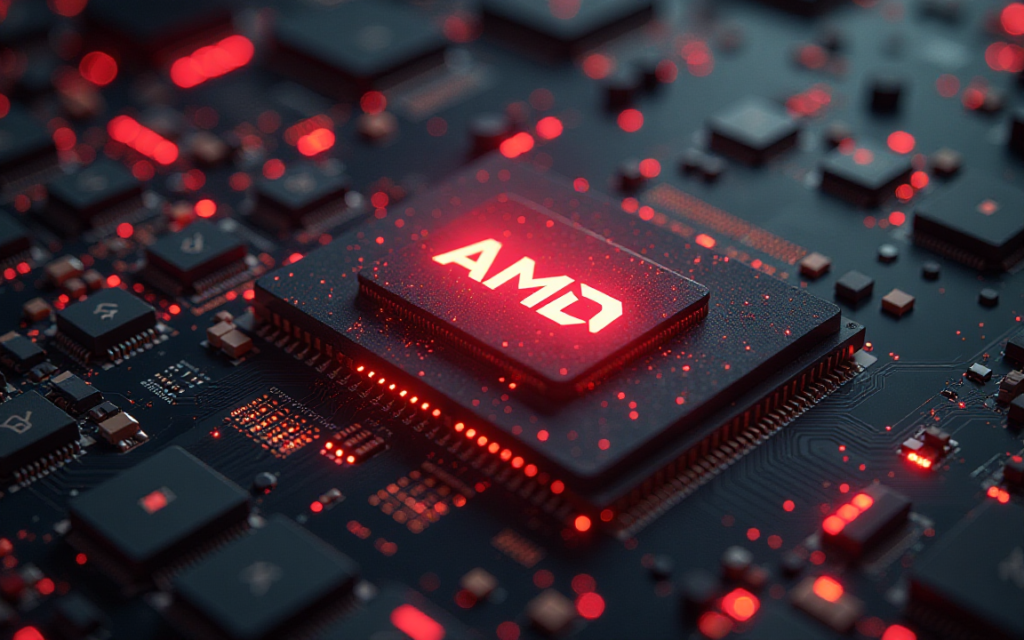Table of Contents
AMD stock represents a high-risk, high-growth investment for potential investors. Its future is linked to the core of technological advancement – in the cloud, artificial intelligence and the devices that we use every single day. In one of the world’s most competitive industries, success will be determined by relentless innovation and flawless implementation. AMD is a company that will remain on the radar of those who have a long-term outlook and are interested in technology stocks. This blog is related to financeinfotech.com.

The Semiconductor Powerhouse: AMD Stock
AMD is a global leader in the semiconductor industry. Since the 1960s, AMD has led the way in innovation by developing high-performance computing technologies and visualization tools that are used to power everything from personal computers and gaming consoles to huge data centers. Investors are attracted to AMD (NASDAQ AMD) because of its remarkable turnaround in the corporate world, its technological leadership and fierce competition. This article offers a comprehensive overview of AMD’s stock. It explores its history, current market position, financial status, and future prospects.
The Long Road: a Brief History of AMD
AMD Stock was founded in 1969 by Jerry Sanders, a group from Fairchild Semiconductor and other executives. It began as a manufacturer of second-source microchips. The young company was able to establish itself as a manufacturer without having to incur the high initial costs of R&D. In the 1980s, AMD was able to manufacture x86 microprocessors under a cross licensing agreement with Intel. This allowed AMD the opportunity to dominate the booming personal computer market.
This relationship paved the way for one of the most intense rivalries in the tech industry. AMD Stock was seen for years as the budget-friendly alternative to Intel. It offered comparable performance but at a lower cost. AMD had periods of success. For example, the launch of the Athlon chip in the early 2000s outperformed Intel flagship products for a while. The years that followed were difficult, with financial difficulties and technology missteps. In 2014, Dr. Lisa Su was appointed as AMD’s CEO. Under her leadership the company undertook a strategic revamp, focusing R&D efforts on developing a high-performance architecture.
Market Position and Competitive Landscape
AMD is active in the fastest-growing and most competitive segments of the tech sector. Its main business segments are:
The Data Center segment includes data center GPUs and server CPUs. The company has become its primary growth engine due to the explosion in demand for cloud computing (AI), enterprise data processing, and artificial intelligence. Client The segment is primarily focused on desktop and laptop PCs with CPUs (Ryzen), and GPUs Radeon. This is AMD’s traditional strength and a major source of revenue.
Gaming This is the discrete GPUs used for PC gaming, such as Radeon. It also includes semi-custom chips which power gaming consoles from Sony and Microsoft. Embedded After the acquisition of Xilinx this segment offers adaptive computing solutions to a variety of markets including automotive, aerospace and industrial applications.
Rivalry Renewed
Intel’s (NASDAQ: INTC), the historic competitor in the CPU market. Intel is still the dominant player in the CPU market, despite AMD’s recent gains. Intel has a large manufacturing footprint and R&D budgets. Both companies are constantly pushing the limits of performance and efficiency. NVIDIA, NASDAQ: NVDA: Undisputed leader of the discrete GPU market. AMD’s Radeon graphics cards compete directly with NVIDIA GeForce. NVIDIA’s dominant position in the AI-data center market, with its CUDA ecosystem and CUDA software, poses a serious challenge to AMD’s Instinct Accelerators. AMD wants to be the main alternative to NVIDIA. However, capturing a significant share of the AI market remains the biggest challenge and opportunity.
The acquisition of Xilinx by AMD Stock in 2022 was a strategic move that diversified AMD’s product portfolio beyond its core markets for CPUs and GPUs. Xilinx leads the field in Field-Programmable Gate Arrays, which are highly customizable chips that can be used in a wide range of embedded systems. This not only created new revenue streams, but also opportunities for product development synergy, by combining CPUs, GPUs, and FPGAs on a single platform.
Take a look at the financials
The financial transformation of AMD under Lisa Su is nothing short spectacular. The company that was once in debt and unprofitable has now become a highly-profitable growth machine. AMD’s revenue increased at an astounding rate from 2017 to 2022. This was largely due to the success of Zen-based products. As the company changed its product mix to include higher-value client and server chips, gross margins increased significantly. The company’s financial strength allowed AMD to reinvest in R&D, and make strategic purchases like Xilinx, without incurring excessive debt.
The semiconductor industry is known to be cyclical. AMD’s Client Segment was negatively affected by the post-pandemic slump in PC sales, which led to a slower growth rate in 2023. The Data Center segment, however, has proven resilient and is still the main driver for the future of the company. Investors pay close attention to the quarterly earnings reports of the company for key metrics such as Data Center revenue growth and gross margin trends. They also look forward at management’s guidance. AMD’s strong balance sheet with more cash than loans allows it to weather these downturns in the market and invest for the long-term.

Future Prospects and Growth Catalysts
The future of AMD is dependent on several technological and strategic trends.
The AI Revolution
Artificial Intelligence is the single biggest growth driver for AMD. NVIDIA dominates the market for powerful processors that can be used to run and train AI models. AMD is aggressively pursuing the multi-billion dollar opportunity with its Instinct series of data center GPUs such as MI300. The company’s goal is to provide a competitive hardware platform combined with a software ecosystem that’s open source (ROCm), as an alternative to NVIDIA CUDA. It is crucial to secure commitments from cloud providers such as Microsoft, Meta and Oracle for the deployment of Instinct accelerators. This could be the key to unlocking a new phase in exponential growth for Instinct.
Data Centers continue to improve
The traditional server CPU market is still a key growth area, even if AI has become a dominant force. AMD’s EPYC processors have steadily gained market share from Intel’s Xeon chips, thanks to their superior core count and performance-per-watt. The demand for powerful and efficient server processors is expected to remain high as enterprises and cloud providers build out their digital infrastructure. AMD’s roadmap for future EPYC generation processors suggests that it is well positioned to maintain this momentum.
PC Gaming and the PC Market
AMD is still a major player in the PC market, despite its maturity and cycles. The innovation in AMD’s Ryzen CPUs, Radeon GPUs and gaming laptops will be crucial to its profitability. AMD’s dominance in the console gaming industry provides a predictable and stable revenue stream. It will continue to provide chips for the current Xbox and PlayStation consoles for many years to come.

FAQs
1. What is the growth potential of AMD stock?
Data Centers, and specifically Artificial Intelligence, have the greatest growth potential. AMD’s revenue and profitability would be impacted greatly if it could capture even a small share of NVIDIA’s AI accelerator market. The continued market share gains of its EPYC Server CPUs are also a major growth vector.
2. What are the main risks of investing in AMD?
The semiconductor industry is cyclical and intense competition are the biggest threats. AMD is up against Intel and NVIDIA, two well-funded competitors. If AMD fails to follow through on its product roadmap, or makes a mistake in technology development, competitors could regain the advantage. A general economic slowdown could also reduce the demand for computers, servers and other electronic devices. This would negatively affect AMD’s sales. Stocks are valued high because they assume significant growth in the future, but this may not happen as expected.
3. Does AMD stock pay dividends?
AMD does not pay dividends at this time. It is a growth focused company and reinvests its profits into the business. This includes research and development, strategic acquisitions and other areas to support future innovation. It is common for high-growth technology companies to do this.
4. What is the impact of AMD’s acquisition of Xilinx?
The Xilinx purchase diversifies AMD’s business and reduces its reliance upon the PC market. The acquisition gives AMD a leadership position in adaptive computing, FPGAs and opens up new high-margin industries like automotive, industrial and telecommunications. This allows the creation of products that combine AMD’s CPU and GPU technologies with Xilinx’s adaptive hardware.
5. Is AMD stock an excellent long-term investment option?
AMD’s long-term value depends on the individual’s investment goals and risk tolerance. The company is known for its innovation and has a leadership team with vision. It also sits at the forefront of major technology trends such as AI and cloud computing. It also faces fierce competitors and operates in an industry that is volatile. Investors who are confident in the company’s ability to execute its long-term strategy in the AI industry may find the stock a compelling investment. However, more conservative investors could be cautious due to the high valuation of the stock and the inherent risks.
Conclusion
AMD Stock is one of the best comeback stories to have ever happened in the tech sector. Under Dr. Lisa Su’s leadership, AMD has gone from being an underdog to a leader in the technology sector, driving innovation. The stock of the company has been a boon to long-term investors. The investment thesis for AMD is based on its ability execute its ambitious roadmap. The company needs to continue to compete with Intel in both the server and client markets, while also mounting a credible threat to NVIDIA’s dominance in AI. The road ahead is fraught, but there are huge rewards.

